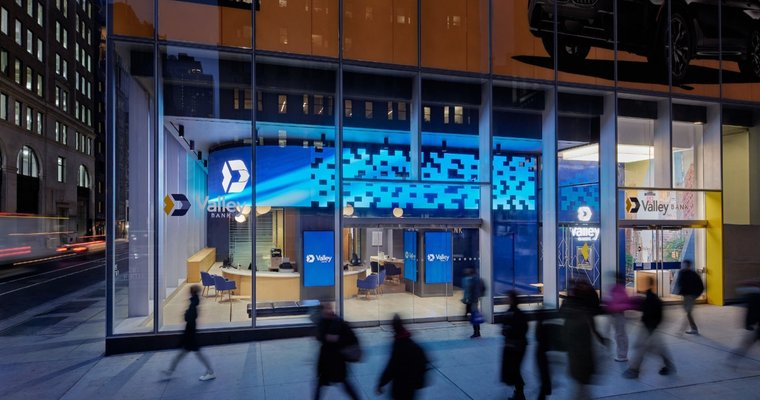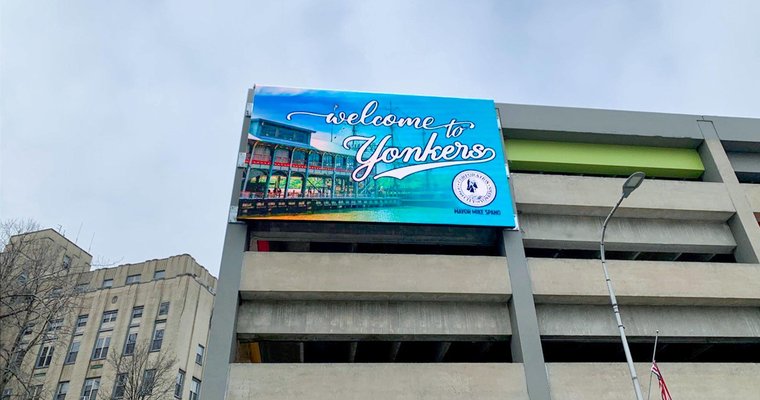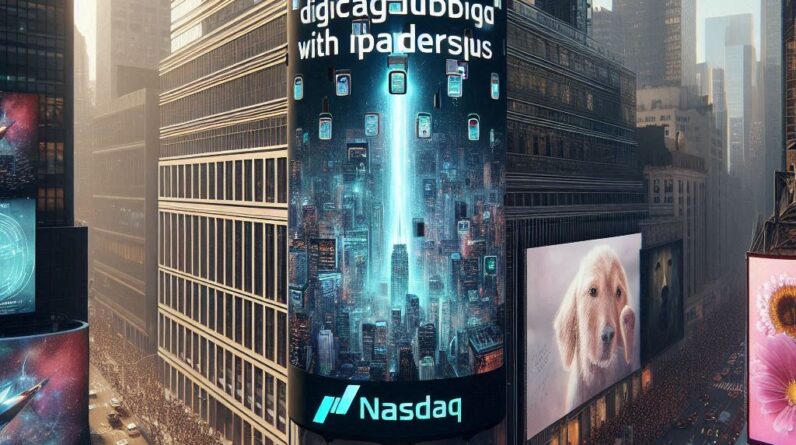
[ad_1]
Is traditional banking dead? In an exclusive interview with Digital Signage Today, Valley Bank representatives argue no. Instead, banks need to deliver both technology and the human touch. The bank described each step of a major digital transformation.
 Valley Bank’s digital transformation in action at flagship Fifth Avenue branch in Manhattan. Courtesy of Valley Bank/Adrenaline.
Valley Bank’s digital transformation in action at flagship Fifth Avenue branch in Manhattan. Courtesy of Valley Bank/Adrenaline.
Is traditional banking dead?
“Traditional banks are still struggling to create a compelling user experience,” wrote Emily Mason in Forbes, noting that polls show a current low American consumer confidence in traditional banking coinciding with the rise of “neobanks” (like the Apple partnership with Goldman Sachs) in the wake of the SVB collapse.
In these conditions, what can traditional banks do to create that “compelling user experience” to win back customer confidence?
Use technology and the human touch, argued representatives of Valley Bank, during an exclusive interview with Digital Signage Today via video link, in which the team described each step of a major digital transformation Digital Signage Today covered in February. Valley is still growing after over a century of operation, and thanks to customer-focused initiatives like this, along with its deeply human approach to banking, representatives said the bank enjoys strong user reviews and confidence, and looks forward to an ever brighter future as it leans into innovation mixed with the human touch.
 |
“Adapt and overcome”
 |
Mark Beausoleil, EVP, director of retail banking, Valley Bank. |
“We have over 200 branches and we are in New York, New Jersey, Florida and Alabama,” Mark Beausoleil, EVP, director of retail banking for Valley Bank, said in the interview. “One of the things that was important to me from a retail banking perspective was that our brand was consistent and relevant across all of our four very diverse states and markets … to really make these facilities as relevant and modern as possible.”
Like many Valley Bank customers, Beausoleil splits his time among different states, particularly New York and Florida. This informed a growing strategy across business categories using digital signage: crafting a unified, brand-identified experience for customers. “So, for me, it was important that when they walk into a Valley [bank], beyond the great service they receive, it should feel like, ‘hey, this is my bank. This looks like the bank that I go to in Manhattan, and it looks like the bank I go to in West Palm Beach, and it feels the same.’ We know we’ve done that from a service perspective, all of our associates deliver that same strong sense of service, but the facilities didn’t have that connection as they should have.”
The digital transformation has been an ongoing effort in partnership with Adrenaline, starting with New Jersey branches and newly-opened ones, with plans to roll out across all branches eventually. The bank invested heavily in the custom approach at its flagship Manhattan branch.
 |
Long term thinking: Hardware, sustainability
In each example, the partners have stressed sustainability as part of the design strategy, both in the standard designs and the flagship branch. “Valley has always focused on kind of making sure we’re environmentally doing the right thing, to the degree that we can, that’s always top of mind,” Beausoleil said.
 |
Jerry Reese, Group Account Director at Adrenaline Agency. |
“We always try to take both power management [and] heat management into account as we’re designing the specific technical solution that goes into a space,” Jerry Reese, Group Account Director at Adrenaline Agency, added, providing additional insights on this topic via email follow-up: “The product we deployed in the Fifth Avenue branch is a highly efficient, direct view LED product,” Reese said via email. “For the required scale and performance of this display, dvLED is the optimal solution compared to traditional LCD-based displays. There’s really no comparison from a power consumption and heat generation standpoint.”
Do these projects indicate that DVLED is becoming the leading go-to for the industry in similar projects?
“Certainly, when you’re talking about large scale, there’s no question,” Reese said. “You can do things with the product today that were … inconceivable just a few short years ago — and certainly still are from an LCD standpoint. The direct view LED product has advanced, and continues to advance, in leaps and bounds, really, year over year.” Reese provided additional insights on this point via email followup: “In terms of the unique physical design, in this [Fifth Avenue] Valley branch where you have the tight 90-degree curve, that’s a capability that’s relatively new in the last few years. But, more and more, LED manufacturers continue to come out with advanced, flexible product that allows that to be done on a much sharper curve, sharper radius than before. So, I think we will still continue to see unique sizes, shapes and configurations [being] used as we go forward.”
 |
Designing a digital experience
 |
Rick Barrick, VP Digital Strategy, Adrenaline Agency. |
“Everything was very purposeful with the design of the branch,” Rick Barrick, Vice President Digital Strategy at Adrenaline, said. “The Valley team did a great job in developing the aesthetics of the branch, and making sure that the digital experience was very symbiotic with that design was a critical function of that.”
This required starting with content, crafting everything around the central ethos and narrative: “What we got as an agency as a creative brief and as a design intent was: (A) make sure the brand is well-represented, and then, (B) make sure that there are connectors to the city of New York, because that’s a key thing. It was mentioned earlier — ‘We’re here, and we’re here to stay.’ And then the other element was that we are about forward-thinking technology. Those are elements that aren’t represented in text; they’re represented visually, through a dense visual experience — because we all remember things much more visually than we do by reading things. And that was kind of the initial palette that we’ve created.”
Barrick also clarified a point on this design via an email follow-up to this interview: “We developed the digital experience so that the corner was a solid canvas and opportunity for brand elements and driving in some connection to the community,” Barrick said. “You’ll notice the pixelated design of both the left and right of that is completely different, something that stands out even in a city as competitive as New York, not too many blocks away from Times Square.”
It was key to make sure that the same identity and experience was being projected, both to customers inside and to passersby outside, and Adrenaline even studied traffic patterns to hone this element. “For example, we knew that the primary choke points for viewing this were going to be in the various pedestrian stop ways as you’re getting ready to cross the street. And all of those visible areas average about 45 to 130 seconds of viewing time based on the way the Department of Transportation works the lights. Knowing that, that corner was the area that had the highest dwell times, which is why it’s the predominant part of the canvas. The pixelated areas create the wow factor and they’re in the areas where you have a five second, 10 second dwell time because once you’re past those choke points, you’re walking, and you need something that’s quick and emotionally connects.”
Project execution and results
“So, obviously, lots of planning goes into this in coordination with Valley to minimize the impact, because this was a functioning open branch,” Reese said. “So, we had to limit the amount of time that it impacted on bank closure. So, this was done over the course of a long weekend. That’s possible through very meticulous planning and coordination — and, obviously, the experience of having done similar things like this in other environments in the past. It’s also about the product that gets selected. And when we bring in a professional team that’s done this, knows how to do it. It’s a design that’s been very meticulously reviewed, [and the] product’s been lined up to go into a deployment plan so that the right pieces are at the right place at the right time. And so, we were able to do this over the course of about three and a half days.”
“I’ll tell you the first time I saw it, particularly that blue picture, it was emotional, because I saw our brand lit up in a way — in Manhattan — that it hadn’t been in the past,” Beausoleil said. “So, there was a [gasp] moment for me, I don’t know how you verbalize it, a catching-your-breath moment, you know, from a human perspective. And then to see other people turning in engaging visually, some people, like, standing there for more than a few seconds, pausing and stopping to say, ‘Oh, that’s Valley Bank. Wow, that’s beautiful.'”
With high numbers of daily passersby, it was important not only to assert the brand identity for existing customers, but to recruit new ones as well; both goals have been met abundantly, according to Beausoleil. In addition to positive feedback from customers, Beausoleil said the digital transformation has brought in high numbers of walk-in traffic. “The customer feedback has been tremendous,” Beausoleil said, noting that walk-in traffic is higher, along with referrals and notable approval among young professionals. “Everybody was pretty delighted with how it looks and how it feels and [it] really, again represents us very well.”
 |
The human element
Still, with the rise of neobanks, lots of brands are offering various flavors of technology; what makes this “wow factor” impact customers with so many options to choose from? What is this canvas trying to “say” to people?
“It’s two things, right?” Beausoleil said. “Yes, Valley is modern. But guess what? That same great service we’ve been delivering for years, that same feeling like you’re walking into a place where you’re welcome, wanted — and will be provided strong financial advice — still remains the same. So that combination for us I think, is a winning game.”
“Listen, I’m one who believes that technology alone doesn’t always win,” Beausoleil added. “And that’s me, personally.” What’s the answer? “Technology coupled with the right human beings touching each other and providing — at least in the banking industry — providing sound financial advice and the technology to navigate, to be able to get your get your banking done efficiently and quickly. If you want to self-serve … you have the ability, but when you need to talk through a complex financial situation, when you need private banking or you need a commercial loan, you have that person available. So, to me I’ve always felt like the technological piece comes together with the human side of banking, and then you’ve got something special for the client.”
“Think of the whole branch as a billboard,” Barrick added, noting that when a person sees an ad for a banking service they may want (playing, by design, during open hours), it makes a difference that they can actually walk inside when they see the ad and get service from a banker. “It’s not just awareness. Now, it’s actionable — whereas the call to action is much more profound and more direct with an experience like that. And that’s a great opportunity.”
What should other banks (and businesses in general) take away from this story in terms of reaching customers?
“I think in markets with high traffic any business needs to be creative in terms of how they are outreaching to bustling communities,” Beausoleil said. “Sometimes it’s a big, bright, bold event, like what we’ve done with Adrenaline, and other times … it’s our bankers being in-market that appeals even more — still having the modern technology to available to clients, but being in the community at a community event, doing volunteerism.”
Despite almost unprecedented changes in banking, business, technology and world affairs, Beausoleil and his team feel confident that their long-term strategy will continue bearing fruit for years to come.
All images courtesy of Valley Bank/Adrenaline.
Daniel Brown is the editor of Digital Signage Today. He is an accomplished technology writer whose experience includes creating knowledge base content for a major university’s computing services department. His previous experience also includes IT project management, technical support and education. He can usually be found in a coffee shop near a large pile of books.
[ad_2]
Source link






